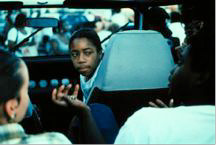
Suzanne Lacy
For one afternoon in 1994, two hundred and twenty high school students in Oakland, California, sat in parked cars on a rooftop garage and talked to each other about violence, sex, gender, family, and race. The teens spoke candidly, without any kind of script, while an audience of nearly one thousand people–including numerous reporters and camera crews–walked from car to car, leaning in and bending over, to hear their conversations through rolled-down windows. The resulting footage of the performance, called The Roof Is On Fire, was aired locally on multiple networks and nationally on CNN.
Oakland teens were already accustomed to receiving media attention, though largely through negative portrayals of young people involved in riots, violence, and conflicts with police. This event, however, which was organized by artist Suzanne Lacy in conjunction with TEAM (a group of teens, educators, artists, and media workers), was designed as a positive media spectacle, with young people depicted as citizens rather than liabilities. For five months, Lacy met weekly with teachers and teens, including those from a nearby probation program, to discuss issues important to them, and to craft a message for civic leaders about the role of young people in Oakland’s future. The Roof Is On Fire reflected the crux of those discussions, as well as Lacy’s decades-long mission to counter misleading media images with empowered, community-oriented actions. Since the 1970s, she has created performances that offer alternative narratives and interpretations of news coverage. For example, In Mourning and In Rage presented a public ritual on the steps of Los Angeles’ City Hall in response to coverage of the murders of 10 women in December 1977. While the stories focused on the random nature of the violence, Lacy’s collaborative performance was a call to action, and reframing of the killing spree from a feminist perspective.
[ About Living as Form | Curator Statement | About the artists ]


